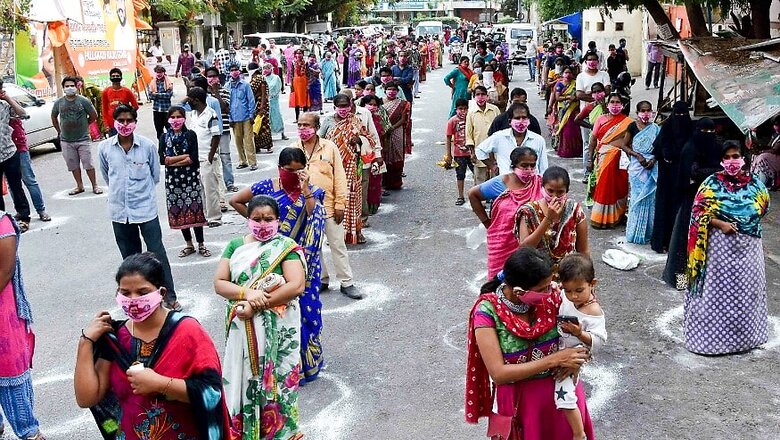
views
Prime Minister Narendra Modi on Monday held the fifth video conference with the chief ministers on tackling Covid-19 as lockdown 3 comes to an end in India on May 17 and the government prepares to open the economy.
Though its geographical area, socio-economic diversity, demographics and politics make India a unique challenge, let us look at some of the lessons it can take from the successes and failures of other countries which have recently eased lockdown restrictions.
The United Kingdom (UK) became the latest entrant to the lockdown-exit club as it announced a conditional plan to reopen society on May 10. Some of the measures undertaken were to allow people to spend unlimited amount of time exercising outdoors, sit in parks and play sports with household members form the 13th of May and to encourage people who cannot work from home, especially from manufacturing and construction industries, to go to office but as far as possible without public transport — using their private cars or by foot or cycle. The second phase could see the reopening of certain shops and primary schools as early as June 1, while hospitality businesses may restart from July 1. A 14-day quarantine for all airport arrivals is also being proposed —a move resisted by the tourism industry which says it will further dissuade people from travelling. A new five-level Covid Alert System has been created. The UK is currently ready to move from level 4 to 3.
Some of these measures have already faced a lot of criticism. Opposition leaders in the UK have questioned the move to encourage people to work from office even as the country is still reporting approximately 4,000 cases and around 300 deaths every day. The UK is the smallest country among the 10 most affected (in terms of number of cases) Covid-19 countries in the world, but has reported the second-highest number of deaths (31,855) only after USA.
Ireland, which had a stricter lockdown than the United Kingdom, has ordered schools to remain shut until September. It has also allowed attending weddings and social gatherings from July 20 but only for family and close friends.
Germany made headlines by announcing its plans to resume the Bundesliga behind closed doors from May 16 — the first major European league to do so. The success of the league will go a long way in determining whether other leagues follow suit. The BCCI may like to observe keenly as it could pave the way for a shortened IPL without spectators in September. Germany has given its 16 states the control of lifting most of the lockdown but ‘emergency brakes’ could be applied by Chancellor Angela Merkel, where there are a surge in new infections — another lesson perhaps for the Indian government to now allow the respective chief ministers to take control, while the Centre steps in only in a crisis.
Some of the other measures introduced in Germany include opening of all shops with extra hygiene and social distancing measures, resumption of schools for young children and those taking exams and people from two different households being allowed to meet each other. However, big public events like festivals are banned till at least the end of August. This is significant for a diverse country like India with a rich tradition of celebrating festivals. Germany has a high number of cases but a very low mortality rate in comparison to other Western European powers.
France is easing travel restrictions for short distance trips outside from May 11. A travel permit would no longer be required. The situation will be reviewed after three weeks. The country will be split into two, with 4 red zones, including Paris. Of particular interest to India would be their phased policy of re-opening education institutions. Primary schools will reopen from May 11 while 11 to 15-year-olds can only go back to school in Green Zones from the 18th of May. Schools for 15 to 18-year-olds will not open before June. There is a limit of 15 students per classroom and masks are compulsory for older children. While all shops will be allowed to reopen, bars and restaurants will remain closed. Gatherings of less than 10 will be permitted and the elderly and vulnerable will be allowed to go out but with precautions.
Belgium has allowed its cafes and restaurants to open from the 8th of June and made it compulsory for all its citizens above the age of 12 to wear masks on public transport. Schools will reopen from May 18 but with a maximum of 10 students per classroom. At 16.31 per cent, Belgium’s mortality rate is one of the highest in the world.
Spain, which has the second-highest number of cases in the world, will only reopen schools in September. Bars and restaurants will not fully open before the 10th of June adhering to strict social distancing norms and only at 50 per cent capacity. Cinemas, theatres and exhibitions will be allowed to open from the 26th of May but at 30 per cent capacity. Religious places like churches and mosques will have limited access from the 11th of May. Spain had imposed one of the strictest lockdowns in Europe.
Italy reported just 802 cases on May 10 and its mortality count is also less than 200 for the last two days. While it was one of the worst Covid-affected countries in the world with a steep rise in cases and deaths over the last two months, it also reached its peak early (March 27-28). It is finally relaxing norms which include more lenient exercising and walking rules, visiting relatives in small numbers, reopening of beauty salons and dine-in services for bars and restaurants and allowing a maximum of 15 people to attend funerals. However, schools will not reopen until September.
Greece, heavily dependent on tourism, is reopening shops and indoor shopping centres while restaurants will be allowed to reoperate from June 1 but only with outdoor seating and a clear distance between chairs.
However, unlike other European countries, Russia’s outbreak is yet to peak. Although the country is reporting a very low mortality rate (0.91%), the number of cases has crossed 2 lakh and is rising — more than 10,000 cases daily in the last 8 days. As such, the strict lockdown will continue in the country. Moscow, which is the worst-affected city, has made it compulsory to wear gloves and masks in shops and on public transport from the 12th of May. Only food shops and pharmacies will be open in the Russian capital which will see severe restrictions continuing till at least 31st May.
The USA, the country most ravaged by the Covid-19 outbreak, is easing restrictions and opening up the economy even as it continues to report more than 20,000 new cases every day. Around 30 states are easing norms even though most of them haven’t met the required guidelines which require evidence of a two week decline in new cases and deaths. According to some experts, this desperation to reopen the economy and get on with things could take the daily death toll numbers in the country to around 3,000 by the 1st of June. The USA currently accounts for nearly one-third of the total cases and 28.46 per cent of the total number of Covid-19 deaths in the world.
Peru, which is the closest country to India in terms of number of cases and deaths, is gradually relaxing restrictions in the mining sector to boost its economic growth — the South American country is the second largest producer of copper in the world.
Many Asian countries such as China, Hong Kong, Taiwan and South Korea, which had managed to control the outbreak with effective contact tracing, lockdowns and social distancing measures later reported a resurgence. Imported infections were the major cause of the second wave with citizens or permanent residents returning to their home countries.
The National Health Commission of China reported 108 new infections with 98 originating from beyond the country's borders — a six week high — on April 13. South Korea saw a resurgence of the virus in 100 people who had fully recovered from it.
The second wave hit Hong Kong around mid March and peaked at the end of the month when a large number of its students and other residents started to return from the West in large numbers. But with prompt, aggressive action from the government, which included barring non-residents from entering the city and strict quarantine measures for all arriving in the city, Hong Kong today reached 22 days without any new locally transmitted infections.
Singapore, which, until late March, was hailed by the world as a model country in the containment of Covid-19, saw a second wave hit them hard from April 16 onwards. The country has reported more than 500 daily cases on all days but one since then. The main cause was the rise of infections among Singapore’s three lakh migrant labourers, many of who live in cramped dormitories on the outskirts of the city. The country had to shut schools and non-essential businesses again, while extending social distancing measures till the 1st of June.
Yet, there were some countries like Japan which saw a second wave with no cases from abroad. The northern island of Hokkaido in Japan redeclared a state of emergency after lifting its initial declaration as double-digit cases were reported each day for a week in the second week of April. People violated social distancing norms and celebrated openly on the streets and cafes when the first set of restrictions was lifted. This led to the second wave. Another possible reason was domestic migration — people from other Japanese towns like Tokya and Osaka travelled to Hokkaido — this included students and business employees.
There are many lessons India can learn from various countries across the world — some which have recently eased their lockdowns and some others which reported a second wave. The challenge is to open the economy and yet stop the infection from spreading at a high rate. Severe restrictions need to continue in the containment areas while the rest of the country opens with strict social distancing regulations. A method has to be devised to protect the old and the vulnerable. Easing of curbs on public transport has to be gradual and non-essential travel within and outside the country minimal.
India might not yet be in a position to reopen its malls, markets, restaurants and theatres and schools and colleges as, unlike most Western European countries, we have still not hit our peak and that may be a good one month away.
Covid-19 in India is still an urban virus with 80 per cent of the affected in the cities. The government has to ensure that with the inevitable movement of the migrant workers back to their villages, the infection does not spread across rural India. Similarly, students and Indians stranded abroad and now returning to India must be put under strict quarantine as there is enough evidence of imported cases leading to a second wave in other Asian countries.
The period just after the lifting of the lockdown is the most crucial for any country as that is where there would be a rise in the number of cases. In India’s case, the problem is compounded as we are yet to flatten the curve.
Add 130-plus crore and its size and diversity and inequalities and the challenges of a highly vibrant democracy — that is what India is confronted with in the coming weeks.















Comments
0 comment